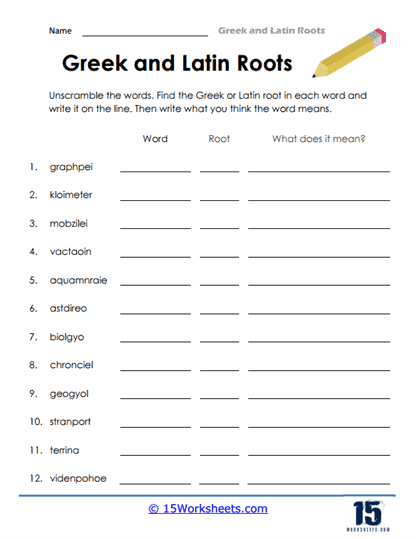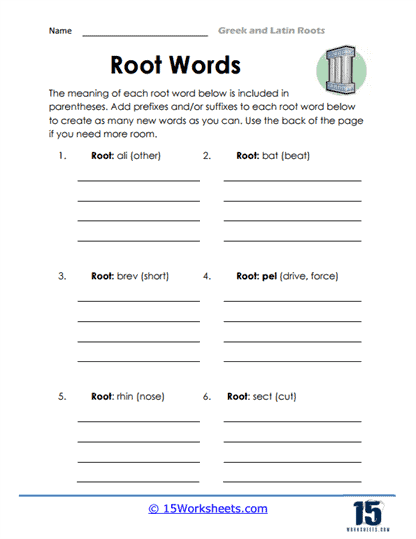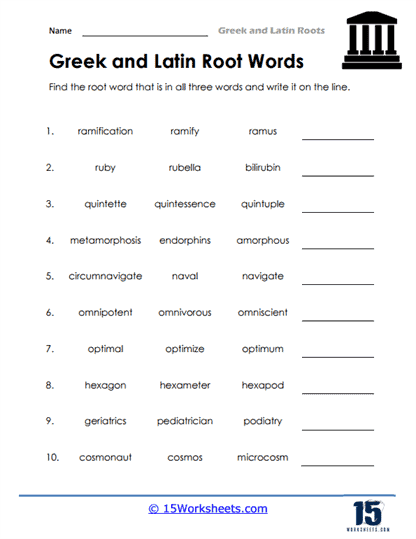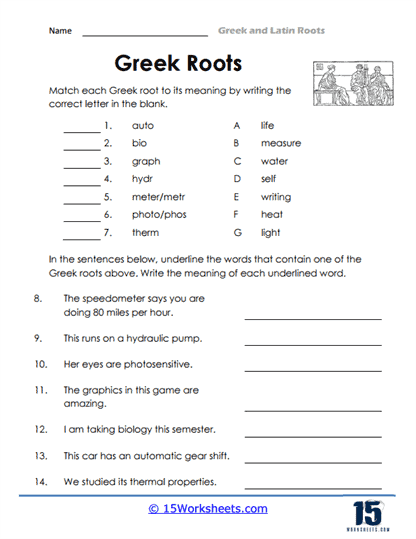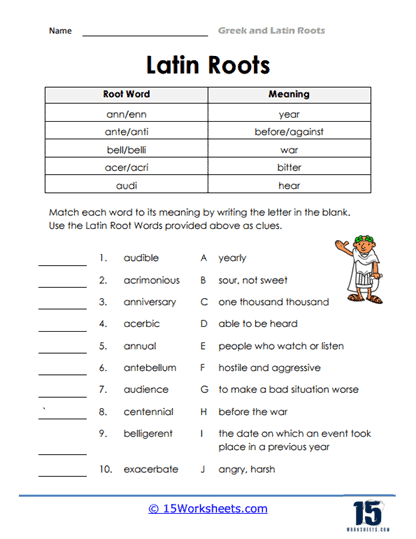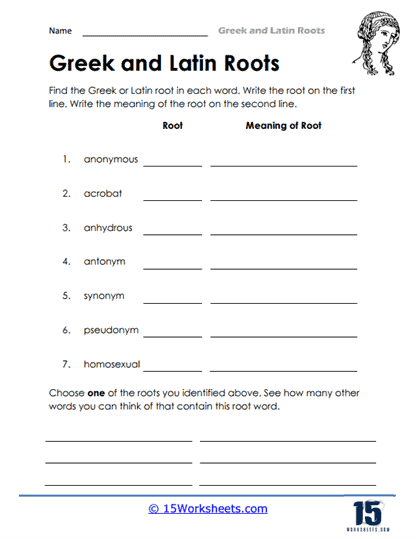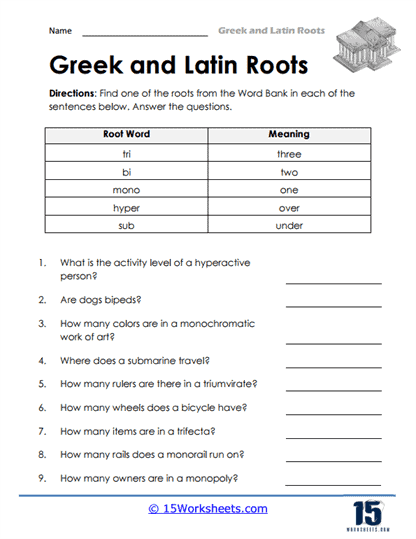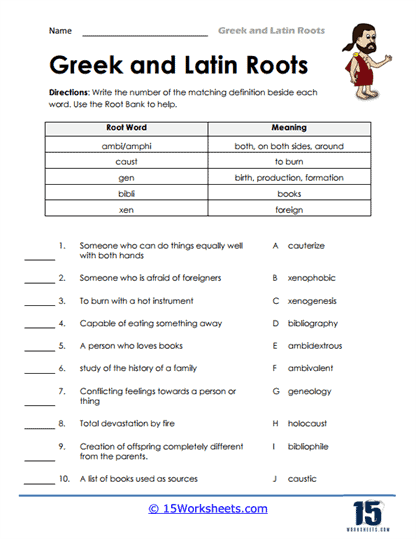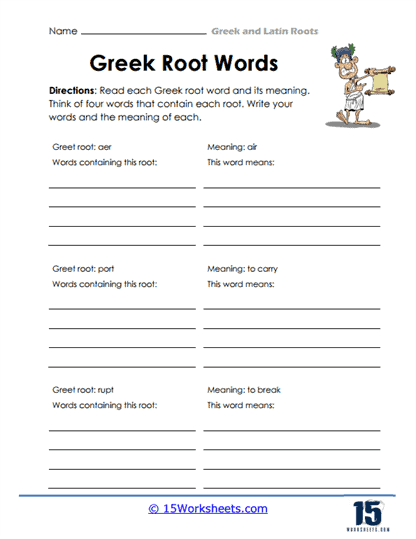Greek and Latin Roots Worksheets
All About These 15 Worksheets
This series of 15 worksheets is designed to help students learn and understand Greek and Latin roots and their meanings. The exercises in these worksheets aim to teach students how to identify, define, and use Greek and Latin roots in their writing and everyday language.
Some exercises in the worksheets include defining Greek root words and writing down words that use them along with their meanings. This can help students develop their vocabulary and learn how to recognize and use different Greek root words in their writing and everyday language.
Other exercises involve identifying the Latin roots in words that use them and their definitions, which can help students develop their language and critical thinking skills. Additionally, students are asked to classify words according to their roots, unscramble the letters in words to identify the root word used and their meanings, and match Greek and Latin root words to their meanings.
Writing prompts are also included to help students showcase their knowledge on Greek and Latin root words, and how they can be used to create new words and expand their vocabulary.
Learning about Greek and Latin roots is an important part of language development, as many words in the English language have roots in these ancient languages. By understanding the meanings of different roots and how they are used to create words, students can develop their vocabulary, reading comprehension, and writing skills.
Overall, these worksheets provide an excellent resource for teachers and homeschooling parents who are looking to help their students improve their language skills and develop a deeper understanding of the origins and meanings of the English language.
How to Learn Greek and Latin Roots?
Greek and Latin roots are the foundation of many English words. By understanding the meaning of these roots, you can often determine the meaning of new words you encounter.
For example, the Latin root word port means “to carry.” So, a word like transportation would literally mean “the act of carrying across.” Similarly, the Greek root word bio means “life,” so a word like biography would be “the story of someone’s life.” Learning these roots can help you quickly decipher new words and expand your vocabulary.
Once you know some of the most common Greek and Latin roots, you’ll start to see how they’re used in many different ways. For instance, the Latin root word tract means “to pull,” so words like attract and contract both feature this root
5 Strategies to learn Greek and Latin Roots
An understanding of Greek and Latin roots can be a valuable tool in your journey to mastering the English language. Here are some strategies to learn Greek and Latin Roots.
1. Understand How Roots Work
To learn Greek and Latin roots, it is first vital to understand how they work. Roots are the building blocks of words, and they can be either real words or made-up words. Real words are known as lexical roots, while made-up words are called combining forms. For example, the word “re” is a lexical root, while “pre” is a combining form.
2. Know What Prefixes and Suffixes to Look For
Once you understand how roots work, you can start to identify them in words. Greek and Latin roots are often found in words with certain prefixes and suffixes. For example, the prefix “anti” often signifies that a word contains a Greek root, while the suffix “ion” often indicates that a word contains a Latin root.
3. Use a Dictionary or Glossary
If you come across a word you don’t know, try looking it up in a dictionary or glossary containing Greek and Latin roots. This can help you figure out the root of the word and its meaning.
4. Practice Using the Root Words
In order to really learn Greek and Latin roots, it is important to practice using them. One way to do this is to make up sentences using words that contain the roots you are trying to learn. For example, if you are trying to learn the root “bene,” you could make up a sentence like “The benefited from taking advantage of the sale.”
5. Make a Word List for the First 100 Words
A knowledge of Greek and Latin roots can help students unlock the meaning of many English words. By understanding the origins of words, students can more easily remember their definitions and usage. For this reason, making a word list of Greek and Latin roots can be helpful. The first 100 roots on such a list might include “a-,” “ante-,” “bene-,” “cide,” “contra-,” “de-,” “dia-,” “dis-,” ” -emic,” “en-/em-,” ” -ennium,” “exo-,” “Extra-,” and so forth. With a comprehensive list of roots at their disposal, students can be well on their way to understanding the mysteries of the English language.
7. Practice Writing the Root Words Out
One effective way to learn roots is to practice writing them out repeatedly. This will help embed the roots in your memory so that you can easily recall them when you need to.
Moreover it’s helpful to create sentences using words that contain the root, as this will give you a better understanding of how the root is used in context. With a little effort, you’ll be surprised at how quickly your vocabulary will grow.



